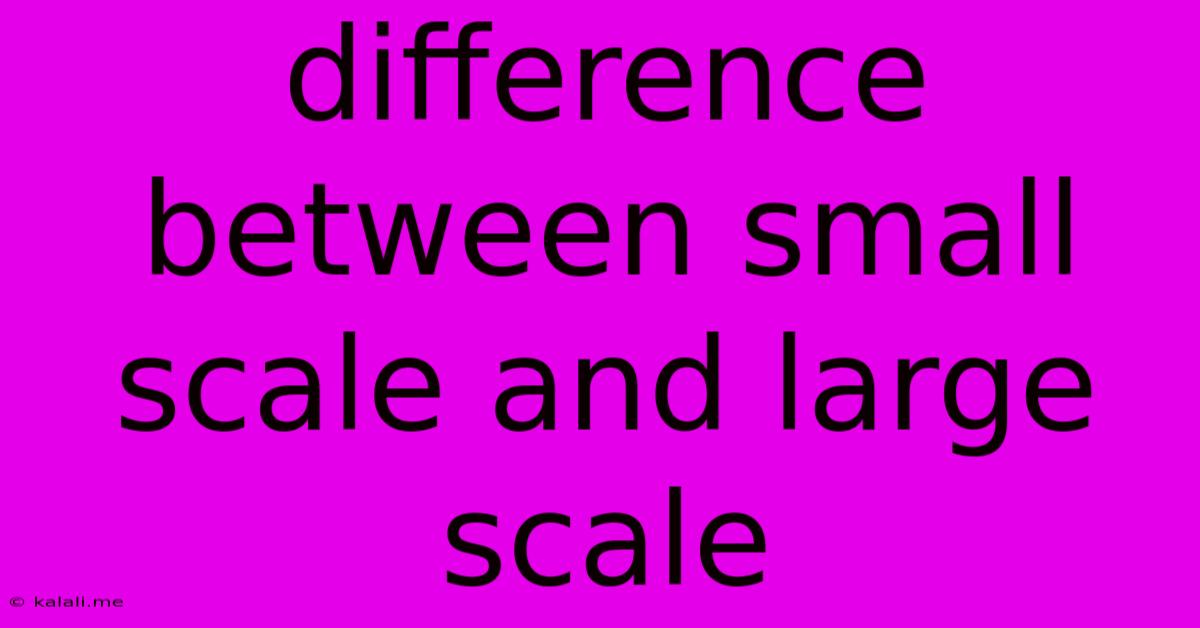Difference Between Small Scale And Large Scale
Kalali
Jun 14, 2025 · 3 min read

Table of Contents
The Great Divide: Understanding the Differences Between Small-Scale and Large-Scale Operations
The terms "small-scale" and "large-scale" are relative and depend heavily on the context. Whether you're discussing manufacturing, agriculture, business ventures, or even scientific experiments, the distinction lies in the scope and impact of the operation. This article delves into the key differences between these two operational scales, examining various aspects to provide a comprehensive understanding. This comparison will help you determine which scale is best suited for your specific needs and goals.
Defining the Scales: A Matter of Perspective
There isn't a universally agreed-upon definition for "small-scale" versus "large-scale." The dividing line often depends on factors such as production capacity, investment capital, number of employees, market reach, and overall impact. A small-scale bakery might produce hundreds of loaves daily, while a large-scale bakery might produce thousands or even millions. Similarly, a small-scale software company might have a handful of employees and a limited product line, whereas a large-scale tech company employs thousands and offers a wide array of services.
Key Differences: A Comparative Analysis
Let's explore the primary distinctions between small-scale and large-scale operations across several dimensions:
1. Scale of Operations:
- Small-Scale: Characterized by limited production capacity, smaller workforce, and a localized or niche market focus. They often operate on a smaller budget and have a simpler organizational structure. Examples include local farmers markets, artisanal craft businesses, and independent bookstores.
- Large-Scale: Features high production capacity, a large workforce, extensive resources, and a wide market reach. They often require significant capital investment and have complex organizational structures with specialized departments. Think of multinational corporations, large-scale agricultural farms, or major manufacturing plants.
2. Resource Management:
- Small-Scale: Resource management is often more hands-on and personalized. Owners are typically more directly involved in all aspects of the operation, from production to marketing. Resource allocation is typically more streamlined and less complex.
- Large-Scale: Resource management involves sophisticated systems and specialized personnel. Large-scale operations utilize advanced technologies and intricate supply chains to manage vast resources efficiently. Decisions often require extensive analysis and planning.
3. Market Reach and Distribution:
- Small-Scale: Market reach is typically limited to a local or regional area. Distribution channels are often simpler and more direct, involving direct sales, local retailers, or online marketplaces.
- Large-Scale: Market reach is often global or national. Distribution networks are complex and extensive, involving wholesalers, distributors, retailers, and potentially international shipping.
4. Financial Resources and Investment:
- Small-Scale: Requires significantly less initial investment capital. Funding sources might include personal savings, small business loans, or crowdfunding. Financial planning is often simpler and less formal.
- Large-Scale: Requires substantial capital investment, often from multiple sources, including venture capital, private equity, or public offerings. Financial planning is crucial and involves intricate budgeting, forecasting, and risk management strategies.
5. Technological Advancement:
- Small-Scale: May utilize basic technology or leverage readily available digital tools. Technological adoption is often driven by affordability and practicality.
- Large-Scale: Often employs advanced technologies to automate processes, enhance efficiency, and improve quality control. Research and development (R&D) plays a vital role in staying competitive.
6. Risk and Reward:
- Small-Scale: Generally carries lower financial risk but also offers lower potential returns. The impact of failure is typically less significant.
- Large-Scale: Higher potential for significant financial gains, but also a higher risk of substantial losses. The impact of failure can be widespread and far-reaching.
Choosing the Right Scale: Considerations for Success
The best scale for your operation depends on your specific goals, resources, and market conditions. Carefully consider your vision, available capital, risk tolerance, and the competitive landscape before making a decision. Thorough market research and a well-defined business plan are essential for success at any scale. Remember that scaling up or down can be a strategic move over time, as your business evolves and adapts to market demands.
Latest Posts
Latest Posts
-
Compare And Contrast Direct Democracy And Representative Democracy
Jun 14, 2025
-
Temperature At Which A Solid Becomes A Liquid
Jun 14, 2025
-
What Is The Outer Boundary Of A Cell
Jun 14, 2025
-
Which Of The Following Statements Is True Of Weld Grooves
Jun 14, 2025
-
Atmospheric Layer Closest To The Earth
Jun 14, 2025
Related Post
Thank you for visiting our website which covers about Difference Between Small Scale And Large Scale . We hope the information provided has been useful to you. Feel free to contact us if you have any questions or need further assistance. See you next time and don't miss to bookmark.